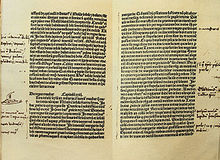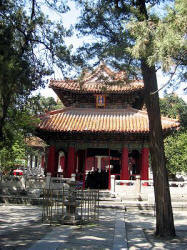Most typically a caravanserai was a building with a square or
rectangular walled exterior, with a single portal wide enough to
permit large animals, such as
camels to enter. The courtyard was almost always open to the
sky, and the inside walls of the enclosure contained stalls,
bays, niches, or chambers to accommodate merchants, their
servants, animals, and merchandise. Caravanserais provided water
for human and animal consumption, washing, and ritual ablutions.
Sometimes they contained elaborate baths. They also kept fodder
for animals and had shops for travelers where they could acquire
new supplies. In addition, shops where merchants could dispose
of their goods could be found.

The Aksaray Sultan Han Caravanserai, built in
1229, is an example of Seljuk architecture in Turkey.
The region of Aksaray was an important stopover along the Silk
Road that crossed through Turkey for centuries.
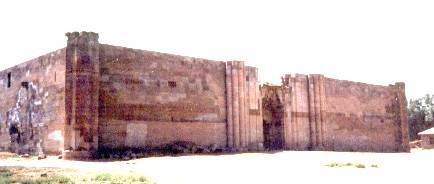
As part of a
series of caravansarais in Anatolia, the Sultan Han was
built in 1236, located between Kayseri and Sivas
in Turkey.
Carpine
Giovanni da Pian del Carpine (or Friar John of Plano Carpini, or
Pian del Carpine, or Joannes de Plano, c. 1180 - 1252). In addition to Marco Polo, other lesser-known European explorers had
travelled to China before Marco Polo, such as Friar Giovanni da Pian del Carpine.
This traveler was one of the first Europeans to enter the court of the
Great Khan of the
Mongol Empire. He is the author of the earliest and invaluable Western account of
northern and
central
Asia,
Rus,
and other regions of the
Tatar dominion. He was the Serbian Primate and Archbishop of Antivari from
1247 to 1252. "Benedict the Pole," a Polish Franciscan friar and explorer,
accompanied Carpine.
The group of Franciscan monks sent as envoys of Pope Innocent
IV to the Mongol Khan, traveled through the dominions of Khan
Batu (ruler of the "Golden Horde") to the vicinity of Karakorum,
where they witnessed the proclamation of Güyüg as the new Great
Khan. The Friar's account of his journey (titled "History of the Mongols"/Historia
Mongalorum) is one of the first direct authentic descriptions of
Asia, and one of the most detailed accounts of
the Mongols in the thirteenth century. The writings are widely
known in Europe through excerpts in an encyclopedia compiled by
Vincent of Beauvais, the Speculum Historiale. (See Benedict the
Pole)
More...
Carthage (Tunisia) existed for nearly 3,000 years on the
Gulf of Tunis,
becoming a large and rich city, and thus a major power in the
Mediterranean. Its central location in the Mediterranean enabled it to
control of the waters between Sicily (Italy) and Tunisia. Carthaginian
commerce covered vast sea and land routes throughout the Mediterranean,
far into the Atlantic, and by land across the Sahara desert. Carthage's
massive merchant fleet, which surpassed even those of the cities of the
Levant, visited every major port of the Mediterranean, Britain, the
coast of Africa, and the Canary Islands. Merchants at first favored the
ports of the east: Egypt, the Levant, Greece, Cyprus, and Asia Minor
(Turkey). However, after Carthage's control of Sicily brought it into
conflict with Greek colonists, it established commercial relations in
the western Mediterranean, including trade with the Etruscans. Carthage
traded in almost every commodity wanted by the ancient world, including
spices from Arabia, Africa and India. Carthage also sent caravans into
the interior of Africa and Persia, while its ships traversed the
maritime trade routes.
According to Roman sources, Phoenician colonists from modern-day
Lebanon founded Carthage in 814 BC (led by Queen Elissa, "Alissar," an
exiled princess of the ancient Phoenician city of Tyre). Carthage was an
international metropolis, and relied heavily on foreign mercenaries,
especially in overseas warfare. The core of its army was from its own
territory in north Africa (such as ethnic
Libyans and
Numidians). These troops were supported by mercenaries from
different ethnic groups and geographic locations across the
Mediterranean who fought in their own national units;
Celtic, Balearic,
and
Iberian troops were especially common. The navy of Carthage was one
of the largest in the
Mediterranean. The sailors and
marines of the Carthaginian navy were predominantly recruited from
the
Punic citizenry, unlike the multi-ethnic allied and
mercenary troops of
the Carthaginian armies. (See Saharan Trade)
More...
Cartography is the study and practice of making
maps.
The earliest known map is a matter of some debate, both because
the definition of "map" is not agreed upon, and because some
artifacts that appear to be maps, might actually not be. A wall painting, which may depict the ancient Anatolian
city of
Çatalhöyük (previously known as Catal Huyuk or Çatal Hüyük
in modern-day Turkey), has been dated to the late 7th millennium
BCE.
More...
Caspian Sea is the largest enclosed body of water on
Earth, commonly referred to as the world's largest lake, or
largest inland sea. It has no outflows, and is bounded by
northern Iran, southern Russia, western Kazakhstan, Turkmenistan, and eastern Azerbaijan. The Silk Road crossed
south of the Caspian Sea through the Caucasus into Anatolia (however, northern routes also were sometimes used by Silk Road
traders). The main route of the Silk Road which was south of the
Caspian connected with trading ships in the Mediterranean, whose routes
stretched to Italy, along with land routes that went either
north through Anatolia or south to North Africa.
More...
During the Middle Ages, the Volga trade route connected Northern Europe and Northwestern Russia with the Caspian Sea, via the Volga
River and was used to trade with regions on the southern shores of the Caspian Sea, sometimes penetrating as far as Baghdad.
More...
Cathay
A medieval name
for China, derived from Kitai (from Kitan, the name of an Altaic tribal and
linguistic grouping). The word came to indicate
China in both Russia and Persia, and spread on to Europe in a
Latinized form as Cathay. The Kitan people, who were related to
the Mongols, had established an empire in northern China during
the 10th-12th centuries. A handbook on perfume, written in 10th
century Egypt, demonstrates contact and trade between the Kitan
Empire and Egypt. The search for fabulous Cathay was a principal
incentive for the great discoveries of the fifteenth and
sixteenth centuries.
"Caves of
a Thousand Buddhas"
(also known as the Dunhuang
Caves, and Mogao Caves/Grottoes). The 'Caves of the Thousand
Buddhas', or Qianfodong, are situated at Mogao, about 25
kilometres south-east of the oasis town of Dunhuang in Gansu
province, western China, in the middle of the desert. By the
late fourth century, the area had become a busy desert
crossroads on the caravan routes of the Silk Road linking China
and the West. Traders, pilgrims and other travellers stopped at
the oasis town to stock up with provisions, pray for the journey
ahead or give thanks for their survival. At about this time
wandering monks carved the first caves into the long cliff
stretching almost 2 kilometres in length along the Daquan River.
Over the next millennium more than 1000 caves of varying sizes
were dug. Around five hundred of these were decorated as cave
temples. When the Silk Road was abandoned under the Ming dynasty
(1368-1644), oasis towns lost their importance and many were
deserted. Although the Mogao caves were not completely
abandoned, by the nineteenth century they were largely
forgotten, with only a few monks staying at the site. Unknown to
them, at some point in the early eleventh century, an incredible
archive - with up to 50,000 documents, hundreds of paintings,
together with textiles and other artefacts - was sealed up in
one of the caves (Cave 17). Its entrance concealed behind a wall
painting, the cave remained hidden from sight for centuries,
until 1900, when it was discovered by Wang Yuanlu, a Daoist monk
who had appointed himself abbot and guardian of the caves.
Dunhuang
BM Tour
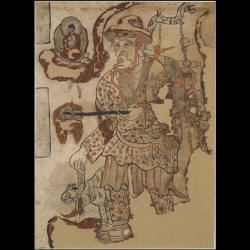
Travelling Monk
Celebi
Evliya Çelebi (اوليا چلبى) Born in 1611, Evliya Celebi
was a
Turkish traveler who journeyed through the territory of the
Ottoman Empire and neighboring lands over a period of forty
years. He began his travels in Istanbul, taking notes on
buildings, markets, customs and culture; in 1640, he started his
first journey outside the city. His collection of notes from all
of his travels formed a ten-volume work called the
Seyahatname (Book of Travels). His writings are widely
accepted as a useful guide to the cultural aspects and lifestyle
of 17th-century Ottoman Empire. This Ottoman traveler is noted
for having made commentaries on the languages spoken in each
region. There are some thirty Turkic dialects and languages
cataloged in the Travelogue. In the ten volumes of his
Seyahatname he describes the following areas and journeys:
Anatolia, Caucasus, Crete, Azerbaijan, Syria, Palestine, Kurdish
regions, Armenia, Russia, Balkans, Hungary, Austria, Crimea, the
Hajj to Mecca, Egypt and Sudan. He died sometime after 1682, it
is unclear whether he was in
Istanbul or
Cairo
at the time. UNESCO has added the 400th anniversary of Celebi's
birth to its list of commemoration events for the year 2011.
Celebi has also been recognized as a major historical figure who
has played a significant role in bridging different cultures and
civilizations.
Cengiz Han (See Genghis Khan)
Central Asia Cultures, conquerors, innovations and ideas
have traversed the region of Central Asia for millennia. Central Asia's role as the conduit
between cultures is symbolized by the "Silk Road," in particular the section of
the Silk Routes which linked Central Asia to China, through which the
civilizations of the East and West interacted. Central Asia is the heart of the largest
landmass on earth
一 Eurasia.
More...
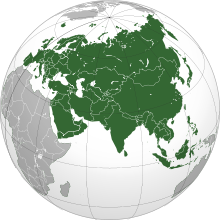
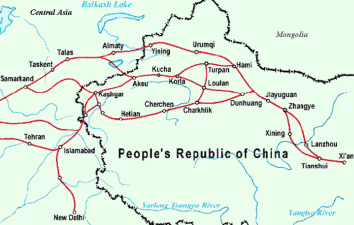
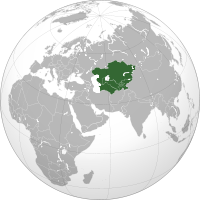
Central Route (Silk Road) ran west along the southern foot of Tianshan
Mountains, passing Loulan (now Ruoqiang), Turpan , Korla, Kuche (Kuqa), Aksu and
Kashgar, then afterwards crossed over the freezing Pamirs to Mashhad via the Fergana
Basin, Samarkand, Bukhara, and finally joined the Southern Route.
Chaghatay Turkic literary language of western
Turkistan that emerged under the Timurid Empire and his
successors.
Chang'an (modern-day Xi'an, see also Shaan)) The starting point of the
famed Silk Road. Xi'an is the capital city of Shaanxi Province and has been the
capital city of China for many
dynasties spread intermittently over a 1,100 year period. The city has over 3,000 years recorded history, with thousands of
artifacts brought to light from 4,000 ancient ruins and tombs.
Changji Hui Autonomous Prefecture Situated in the
center of Xinjiang in China, Changji Hui Autonomous Prefecture
is bounded on the east by Urumqi and Hami and Turpan to the
south, while Mongolia lies to the northeast of the
prefecture. The prefecture lies at the foot of the Tianshan
Mountains on the southeastern edge of the immense desert in the
Junggar Basin. The terrain in which Changji is situated inclines
to the south and is part of the hinterland of Asia. The
administrative division is made up of four counties (Hutubi,
Manas, Qitai, Jimsar); one autonomous county (Mori Kazak
Autonomous County); and two county-level cities (Changji, Fukang).
Chao
Ban Chao In 73AD, the Han government sent a diplomatic
mission of 36 people led by Ban Chao to Xiyu. His assistant Gan
Ying arrived at Daqin (ancient Rome), on the Persian Gulf. Ban Chao
(or Pan Chao), was known as the Chinese general who restored the Tarim
basin under Han government's
power, and maintaining entire control of the area as west as Kashgar. He sent out emissaries to the area west and beyond the Tarim
basin, including the area of modern-day Iran and the Persian Gulf.
Gan Ying was the first Chinese envoy to Ta-Ts'in (the Roman Orient).
Gan Ying, was a Chinese military ambassador who was sent from Kashgaria
in 97 AD on a mission to Rome by the Chinese general Ban Chao.
In order to establish trade relations with Rome directly, Gan
Ying was dispatched by Ban Chao to Da Qin (the old name of the
Roman Empire), which was the farthest westbound travel and
exploration. He set out on his journey from Qiuci (now Kuche or
Kuqa). He finally reached the Persian Gulf by way of Tiaozhi
(Iraq) and the Anxi Empire (Parthia). At that time, Anxi was a
key transit station on the Silk Road. The merchants of Anxi
monopolized the trade between China and Rome; and made a big
profit selling Chinese silk to Romans. Therefore, the Anxi
merchants exaggerated the hardships of crossing the sea and
persuaded Gan Ying to give up his travel. As a result, Gan Ying
followed their advice and returned to China. Although Gan Ying
failed to finish his mission, he brought back more detailed and
reliable information about Central Asia. In historical records,
he is the Chinese who went the furthest west during antiquity
and gathered information about regions to the west of China.
Chao
Hwi Chao (713-741) Korean monk who was raised in China. He traveled to India via a sea
route, where he lived there for several years and visited various
Buddhist kingdoms in India, Persia and Afghanistan. On his returning journey,
he traveled to Kashmir, Kabul, passed the Pamirs and entered Xinjiang from
Tashkurgan, then skirted around the Taklamakan desert from the northern towns,
Kucha, Turfan and Hami. His account The Record to Five Indian Kingdoms
provided valuable information on the Islamic and Buddhist distribution among the
Central Asian kingdoms during the 8th century. The book had been lost since the Tang
Dynasty until an incomplete copy was discovered by the French explorer, Paul Pelliot, at Dunhuang cave, in 1908.
Chardin
John Chardin (c.1664-1677) A French Hugenot jeweler, Chardin spent significant
time in the Caucasus and Persia and traveled to India. His is one of the major
European accounts of Safavid Persia, whose value is enhanced by his good
knowledge of Persian. Persecution of Protestants in France forced him to flee to
England, where he was recognized as an expert on the Middle East.
Checkpoints As the monk Xuanzang
and many other monk travelers attested to, there were many Chinese government
checkpoints along the Silk Road that examined
travel permits into the Tang Empire.
Furthermore,
banditry was a problem along the checkpoints and
oasis towns, as
Xuanzang also recorded that his group of travelers were assaulted by bandits on
multiple occasions. Security and stability was provided along the Silk Routes in the middle of the 13th century when the family of Genghis Khan
controlled Asia from the coast of China to the Black Sea. This period in which the Mongols
were in charge of safe
routes is known as Pax Mongolica.
Cheng
Ch’en Cheng A major mission which set out for Central Asia in 1413, was led by Ch’en Cheng, a Chinese civil servant with wide experience of foreigners. Two
documents of Cheng’s relating to his journey survive. Central Asian envoys
accompanied this mission back to China, bringing with them gifts, and a white horse
for the Chinese emperor.
Cherchen Cherchen is a river oasis town along the
southeastern rim of the Taklamakan Desert in the Xinjiang Uyghur
Autonomous Region in China. It is the largest town east of
Khotan in southern Xinjiang. This area has an ancient human
history, based on the 3,500-year-old graves and mummies that
have been found. Marco Polo visited the city in 1273.
More...
Chien
Chang Chien/
Ch'ien
(or
Zhang Qian) (d.
114
BCE)
The Han Dynasty
in
China is credited with opening the Silk Road
largely through the missions and explorations of General Zhang Qian
(Chang Ch'ien), who can be considered the “Father of the Silk Road.” But
credit must also be given to Emperor Wudi (Wu Di) of the Han Dynasty (206 BC- AD 220),
for it can be said that his outward vision was responsible for the birth of the Silk Road.
In 138 BCE, the Emperor sent
the imperial emissary Qian out as a scout. He
traveled for years, gathering intelligence and trying to forge
alliances for the Emperor. Qian went as far as the Pamir
Mountains (in present-day Tajikistan), and upon his return
provided reports about the peoples, and the magnificent Central
Asian horses, he had seen on his journey. Other travelers
followed in his footsteps and the Silk Routes began to thrive.
Simi Quin is responsible for the "Record of the Grand Historian"
which describes early Chinese history with an emphasis on Zhang
Qian and other explorers.
Wudi's desire for making peace with the Western regions, and the two
missions of General Qian (the first between 138-125 AD; and the second 119-115
AD) are known to have led to the establishment of not only diplomatic contacts
and economic relations, but also to cultural exchanges between East and West.
After the reports given to Wudi by Gen. Qian, concerning products and
kingdoms in the West (such as the previously unknown kingdoms of Ferghana,
Smarkand, and Bokhara), Wudi sought to develop further contact. Some items from the
West that were brought back to China included Ferghana
horses and furs. Later, kingdoms in Central Asia also sent their own emissaries
to Chang'an in China.
His mission from Emperor Wudi aimed to recruit the
Yueh-chih people to form an alliance against the Xiongnu (or Hsiung-Nu, a
nomadic empire of the Mongolian Steppe, along China's northern
frontier). During Chien's first trip (138-125 BCE)
he skirted the Taklamakan desert via the northern route, passed the Pamir, then
reached Ferghana. He returned via the southern route. His second trip (119-115
BCE), a
mission to seek alliance with Wu-sun people, took him to Dunhuang, Loulan, Kucha,
then the capital of Wu-sun kingdom in the Ili river. His missions to the West
led to the formalization of trade, especially the silk trade, between China and
Persia. In addition to traveling himself, Chien sent his assistant to visit
the Fergana Valley (Uzbekistan), Bactria (Afghanistan), and
Sogdiana (Uzbekistan), who gathered information on Parthia,
India, and other regions.
It should be noted that King Mu of Zhou (Mu Wang), the West Chou king, is the earliest reputed Silk
Road traveler (the dates of his reign are c. 976-922). His
travels provide insight on China’s relationship
with Inner Asia before the famous 138 BCE journey of Zhang Qian. His travel account Mu tianzi zhuan,
was written sometime in the 5th - 4th century BC, and is the
first known travel book on the Silk Road. (See also Wudi, and Zhang Qian)
More...
China & the Silk Road
More than half of the network of main trade routes of
the "Silk Road," which enabled communication, trade and
travel between the vast distances stretching from China
to Turkey, are located in the modern-day People's
Republic of China. The Chinese section of the Silk Road includes: 1)
Land routes in Henan Province, Shaanxi Province,
Gansu Province, Qinghai Province, Ningxia Hui Autonomous
Region, and Xinjiang Uygur Autonomous Region, as well as 2)
Sea Routes in Ningbo City, Zhejiang Province and
Quanzhou City, Fujian Provinc (from Western-Han Dynasty
to Qing Dynasty).
See list
whc.unesco.org
Land Route of the Silk
Henan Province
Gongyi Stone Cave Temple - Luoyang City
Luoyang city of Han and Wei Dynasties - Luoyang City
Luoyang City of the Sui and Tang Dynasties - Luoyang
City
White Horse Temple - Luoyang City
Han'gu Pass and Xiaohan Ancient Path in Han Dynasty
Shaanxi Province
Site of the Chang'an City of Han Dynasty -
Xi'an City
Mao Imperial Mausoleum of Han Dynasty and Tomb of Huo
Qubing - Xingping City
Tomb of Zhang Qian - Hanzhong City
The Dagoba of Kumarajiva - Xi'an City
Site of the Chang'an City of Tang Dynasty - Xi'an City
Xingjiao Temple Pagoda (Xuan Zang's Dagoba) - Xi'an City
The Underground Chamber of Famen Temple - Baoji City
Daqin Monastery Pagoda - Xi'an City
Zhao Imperial Mausoleum - Xianyang City
Qian Imperial Mausoleum - Xianyang City
Great Buddha Temple Grottoes in Bin County - Xianyang
City
Xi'an Mosque - Xi'an City
Ningxia Hui Autonomous Region
Historic City of Guyuan - Guyuan City
Cemetery of Northern Dynasties and Sui and Tang Dynasty
in Guyuan - Guyuan City
Site of Kaicheng - Guyuan City
Mount Xumi Grottoes - Guyuan City
Gansu Province
Maijishan Grottoes- Immortal Cliff Grottoes - Tianshui
City
Shuiliandong (Water Curtain Cave) Grottoes- Lashao
Temple - Tianshui City
Bingling Temple Grottoes- Xia Temple - Linxia Hui
Autonomous Prefecture
Site of Yunen Gate and Hecang City - Dunhuang City
Suoyang City Site and Tomb Complex - Jiuquan City
Camel City Site and Tomb Complex - Zhangye City
Guoyuan- Xincheng Tomb Complex - Jiayuguan City
Great Buddha Temple - Zhangye City
Mati Temple Grottoes- Jiata Temple and Qianfo (thousand
Buddhas) Cave - Zhangye City
Yulin Grottoes - Jiuquan City
Xuanquanzhi Site - Dunhuang City
Xinjiang Uygur Autonomous Region
Ancient City of Jiao River - Turpan City
Ancient City of Gaochang and Astana Cemetery - Turpan
City
Taizang Tower - Turpan City
Buddha Subash Temple Site - Aksu Area
Ancient City of Loulan - Ba YinGuoLeng Mongolia
Autonomous Prefecture
Niya Site - Hetian Area
Kizil Grottoes - Aksu Area
Kumtula Grottoes - Aksu Area
Simsem Grottoes - Aksu Area
Bezeklik Grottoes - Turpan City
Toyuk Grottoes - Turpan City
Mehmud Qeshqeri Tomb - Kashgar City
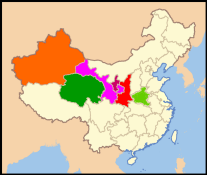
Sea Route of the Silk Road
Ningbo City
Quanzhou City
The Silk Road is the ancient trade route that starts
in the old capital of Chang'an, the present-day Xi'an
city and the center of politics, economy, and culture in
a long period of ancient China. It refers to the
overland commercial route connecting Asia, Africa and
Europe, which goes over the Longshan Mountain, follows
Hexi Corridor, passes Yumenguan Pass and Yangguan Pass,
reaches Xinjiang, stretches along the oasis and the
Pamir Plateau, enters the Central Asia, crosses Central
Asia, Western Asia and Southern Asia, and then leads to
Africa and Europe. It also served as an important trunk
road where the economic, political and cultural
exchanges between the Orient and the West were taking
place. In its very first beginning the function of the
trade route is to transport silk, the fine, delicate,
elegant and portable goods, representing the
civilization of ancient China which enjoyed advanced
agriculture and well-developed handicraft industry.
Therefore, when the name of "Silk Road" was first given
by the German geographer Ferdinand Freiherr von
Richthofen in the 1870s, it was widely accepted.
A large number of information in archeology and
palaeoanthropology showed that the Silk Road had
functioned as the main road for migration and
communication before the Western Han dynasty (206 BC -
25 AD). But the well-documented and conscious
communications and exchanges between the different
civilizations of the East and the West started in the
Western Han dynasty of ancient China. In the second year
of Jianyuan (139 BC) and subsequently in the second year
of Yuanshou (119 BC) of the Western Han dynasty, Liu Che,
Emperor Han Wudi, dispatched Zhang Qian as his special
envoy to the Western Regions (the areas west of
Yumenguan Pass, including present Xinjiang and parts of
Central Asia) so that the relations between the people
of China's Central Plains and the peoples and states of
Western Regions became closer. Such an unprecedentedly
great undertaking contributed to the establishment and
development of the Silk Road. As a result, the growth of
merchandise trade and traveling changed the daily life
of the peoples along the road greatly.
In Wei-Jin period (220 - 420), the Central Plains
were plunged in war turmoil and thus the direct tour
from the Western Regions to Chang'an was on the hazard.
But the communications between the political powers of
Europe, Africa, Southern Asia and Western Asia and those
along the Hexi Corridor that took the responsibilities
preserving the essence of Chinese traditional
civilization remained unaffected. In fact, it was
through the trade with the west that the political
powers maintained their continuities. During this
period, the Buddhism was introduced along the Silk Road
on a large scale. In the areas of Xinjiang and Gansu it
was, consciously or unconsciously, altered to suit the
local societies in the process of popularization. In the
period of the Northern Dynasties (386 - 581), with the
strengthening of the unification tendency appearing in
both the east and west ends of the Silk Road, and as the
powerful empires emerged one after another, the traffic
facilities, safety conditions and social order along the
Silk Road had been improving continually. Thanks to
these, the Silk Road reached its height of power and
splendor.
After the Rebellion of An Shi (755-763), the regime
of the later Tang dynasty gradually shank into the
hinterland and Tubo (ancient name for Tibet) took up the
middle section of the Silk Road. The communication
between China and Central Asia, Western Asia and the
rising Arab Empire, turned to increasingly growing sea
route or made a detour through even more northern
grassland. At that time the Silk Road entered the period
of adjustment, but the friendly exchanges and the
national amalgamation tended to be enhanced further. The
emergence of Mongol Empire changed the relationship
between Asia and Europe in the international arena
greatly and objectively speaking, the passage between
the East and the West was got through, which made the
communications between different peoples more convenient
for more options were offered. In this way the Silk Road
was no more the only road to transport goods, so its
strategic status was less significant.
After the Yuan dynasty (1279-1368), the society and
culture of China came into a stage of long-time
adjustment and inward reflection while the world stepped
into the process of modernization. During this process,
the traditionally classical states gradually went into
decline or desegregation. At the same time, the sea
trade developed further and weighed more than the
overland trade from both importance and scale. However,
even in this period, the use of promoting cultural
exchange of the Silk Road had not lost completely. A
good example is Islam spreading to the east, which
marked the most significant event during this period.
Eventually ten Moslem peoples came into being in
Xinjiang, Gansu and Shaanxi, ie, the eastern section of
the Silk Road. After 1840, China was forced into joining
the unfair international order set up by the Western
European powers. And the peoples and states along the
Silk Road suffered a series of invasions by capitalism
powers to different extents. From then on, the Silk Road
finished its historical mission finally.
The Silk Road had been playing the role of a bridge
linking the economies and cultures between the ancient
East and West as well as connecting the friendship of
China and Eurasia. In the process of its formation and
development, the major religions and cultures in the
ancient world made plenty of communications, exchanges
and amalgamations, which boosted the human being to
create splendid and influential civilization and left
behind valuable cultural legacy. Serving as a passage to
connect the Eurasia together to exchange cultures, the
Silk Road meets well the definition and requirements of
the World Heritage Centre (WHC), reading "A cultural
route is a land, water, mixed or other type of route,
which is physically determined and characterized by
having its own specific and historic dynamics and
functionality; showing interactive movements of people
as well as multi-dimensional, continuous and reciprocal
exchanges of goods, ideas, knowledge and values within
or between countries and regions over significant
periods of time; and thereby generating a
cross-fertilization of the cultures in space and time,
which is reflected both in its tangible and intangible
heritage."
Since the Chinese section of the Silk Road associates
with the vast areas of the following six provinces such
as Shaanxi, Henan, Gansu, Ningxia, Qinghai and Xinjiang,
this section is located in the converging area where the
civilizations of agriculture, grassland farming and the
oasis meet and the cultures of the East and West
intersect. Therefore, as a kind of precious cultural
heritage, the Chinese section was characterized by the
inseparability between the section and the whole road as
well as the unique regional and folk flavors that were
deeply rooted in traditional Chinese culture.
Thereby, as the single world heritage, the Chinese
section of the Silk Road also has the following
characters:
1. Determined by its geographical location and
natural environment, the Chinese section of the Silk
Road becomes the key and the only section for presenting
and preserving the historical process of the cultural
exchanges and amalgamations between the ancient East and
West in all aspects. The integrity of this section is a
unique trait that other sections do not have.
2. The cultural connotation of the Chinese section of
the Silk Road shows strong transition features. From the
west to the east of it, how the other civilizations met,
interacted and merged with the traditional Chinese
cultural and how they became an integral part of the
great Chinese civilization were clearly displayed.
3. The Chinese section of the Silk Road presents
strong multinational characteristic and multicultural
style. In history the ancestors living in this region
created brilliant civilization in merging together the
cultures of the nationalities of Han, Tibetan, Uighur
and Qiang as well as the Western Regions.
4. The Chinese section of the Silk Road shows the
historical truth and keeps the records of the dual
functions of outputting and learning that the ancient
China took during the course of cultural exchanges along
the Silk Road. In this course, the great vigor and
potentials of Chinese civilizations fully reveal itself
by absorbing other cultures, adopting excellent things
from them and adapting them to suit the Chinese
situations.
To further read about the most representative parts
in the cultural heritage of the Chinese section of the
Silk Road and justification of outstanding universal
value click here
Click for original source to continue
More...
Chinggis Khaan (Genghis Khan) By the middle of the 13th century,
under the leadership of Genghis Khan (ca. 1162-1227), the
Mongols controlled Asia from the coast of China to the Black
Sea and west to the Mediterranean (the large sea located between Europe,
northern Africa and southwestern Asia). After Genghis Khan's
death, the Mongol Empire (1206-1368) was led by Kublai Khan who
completed the conquest of China and established the Yuan Dynasty
between 1271-1368. The unified Mongol Empire enabled the Silk
Road to remain an important means of trade and communication. It
was during this period European travelers arrived in China, and
as a result of Kublai Khan's tolerance of religious diversity, a
wide range of people settled in China and along major cities of
the Silk Road. (See Genghis Khan)
Chola Dynasty also referred to as the South Indian Chola
Kingdom, build a navy and conquered the islands of Sri Lanka, Java, and
Sumatra, politically connecting India and Southeast Asia. The Cholas
excelled in foreign trade and maritime activity, extending their
influence overseas to China and Southeast Asia. Towards the end of the
9th century, southern India had developed extensive maritime and
commercial activity. The Cholas, being in possession of parts of both
the west and the east coasts of peninsular India, were at the forefront
of these ventures. The Tang dynasty of China, the Srivijaya empire in
the Malayan archipelago under the Sailendras, and the Abbasid Kalifat at
Baghdad were the main trading partners. Chinese Song Dynasty reports
record that an embassy from Chulian (Chola) reached the Chinese court in
the year 1077. This embassy was a trading venture and was highly
profitable, for they returned with "81,800 strings of copper coins in
exchange for articles of tributes, including glass articles, and
spices."
Christianity
Like other great religions,
Christianity thrived and was spread for hundreds of centuries along the
Silk Road.
Christianity is a monotheistic religion based on the life
and teachings of
Jesus of Nazareth as presented in the
New Testament. Adherents of Christianity are called Christians.
After the rise of Manicheism (which originated in the 3rd century in
Sassanid Persia, Iran) Christianity penetrated from the Near East to Central
Asia, and further to China. The first eastward wave is connected with the
activity of Nestorians. In the 13th century the Silk Road was the route for the
new wave of Christian doctrine dissemination connected with the activity of
Catholic missions. More...
Ch'u-ts'ai
Yeh-lü Ch'u-ts'ai Great Kitan statesman and poet who became advisor to
Genghis Khan and his successors. Traveled with Genghis Khan and his army to
Central Asia in 1219. Journeyed to Altai, Ili valley, Talas, Samarkand, Buhara.
His impression on the prosperous Bukhara can be read on some of his poems.
Returned via Tienshan, Urumqi, Turfan, and Hami. His travel book Xi Yue Lu
(The Travel Record to the West) is only available in Chinese.
Chuaci
Yilu Chuaci From 1222 to 1223, Yilu Chucai, a famous poet in
the Yuan Dynasty (1279-1368), and the Taoist patriarch Qiu Chuji,
toured the Silk Road and vividly described the local customs and
folk culture in Xinjiang and Central Asia.
Chuji
Qiu Chuji The Taoist patriarch Qiu Chuji toured the Silk Road,
from 1222 to 1223, and described the local
customs and folk culture in Xinjiang and Central Asia. (See
Chang Chun)









